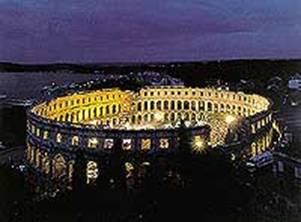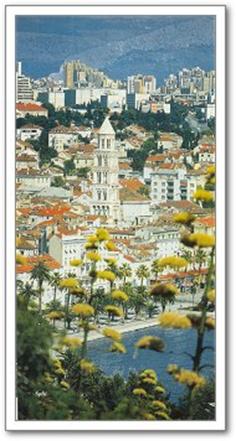ISTRA & NORTH DALMATIA
OVERVIEW: Day 1: Arrival Porec (UNESCO) |
Detailed Itinerary
Day 1: Arrival to Poreč, Croatia
Upon landing to the airport of Ljubljana – Slovenia, or Trieste – Italy, you will be met by our representative and transferred to Poreč, Croatia for overnight.
 Overnight in Poreč – Hotel Palazzo 4*
Overnight in Poreč – Hotel Palazzo 4*
Day 2: Poreč – Rovinj – Pula – Opatija
Poreč is a pretty little place set on a small promontory and cut into an ordered mesh of streets that dates from its time as a Roman encampment. The ancient Decumanus still runs straight through the center and the Roman forum. The Romans conquered the region in the 2nd century BC and made Poreč an important administrative centre, from which they were able to control a sweep of land from the Lim Fjord to the Mirna River. Poreč’s street plan was laid out by the Romans, who divided the town into rectangular parcels marked by the longitudinal Decumanus and the latitudinal Cardo.
A short, beautiful, drive along the sea will bring us to Rovinj. Originally an island, Rovinj was first mentioned in the 7th century as Ruvignio, but it is believed that the town emerged at least several centuries earlier, possibly between the 3rd and 5th centuries. It was settled by Slavs in the 7th century and began to develop a strong fishing and maritime industry. We enjoy a walking tour of Rovinj. This beautiful fishing port is in fact mostly Italian speaking. Shops line the narrow streets of the old town selling everything from local Istra wines and grappa to the region's tasty olive oil and truffles. Above the old town stands the largest gothic church in Istra, the Basilica of Santa Euphemia. This is a culmination of a number of earlier churches, remains of which are still evident. The first, the Oratory of St Maur (who is said to have lived in a house on this site), is in scattered pieces on the north side of the basilica, a secret place of worship dating from a time when Christianity was still a clandestine religion.
 We continue our journey to Pula, with its’ impressive 1st century Roman amphitheatre overlooking the harbour northeast of the old town. Built entirely from local limestone, the amphitheatre was designed to host gladiatorial contests and could accommodate up to 20,000 spectators. The Roman walls mark the eastern boundary of old Pula. We follow these walls south and continue down Giardini to the Triumphal Arch of Sergius. This majestic arch was erected in 27 BC to commemorate three members of the Sergius family who achieved distinction in Pula. Until the 19th century the arch was backed by the city gate and surrounded by walls that were pulled down to allow the city to expand beyond the old town. The pedestrian street beyond the arch, Street Sergijevaca, winds right around old Pula. We will follow the street to the ancient forum the town’s central meeting place from antiquity through the middle Ages.
We continue our journey to Pula, with its’ impressive 1st century Roman amphitheatre overlooking the harbour northeast of the old town. Built entirely from local limestone, the amphitheatre was designed to host gladiatorial contests and could accommodate up to 20,000 spectators. The Roman walls mark the eastern boundary of old Pula. We follow these walls south and continue down Giardini to the Triumphal Arch of Sergius. This majestic arch was erected in 27 BC to commemorate three members of the Sergius family who achieved distinction in Pula. Until the 19th century the arch was backed by the city gate and surrounded by walls that were pulled down to allow the city to expand beyond the old town. The pedestrian street beyond the arch, Street Sergijevaca, winds right around old Pula. We will follow the street to the ancient forum the town’s central meeting place from antiquity through the middle Ages.
Later we continue to Opatija, the oldest established and still one of the most popular Croatian resorts town, in the best tradition of seaside magnificence. A Rijeka businessman built the first villa here in 1844, and after a visit by the trend-setting wife of the Austrian Emperor, the town was promoted as a handy health resort for aristocratic Austrians.
Overnight in Opatija – Hotel Astoria 4* (B)
Day 3: Opatija - Rijeka - Senj - Plitvice Lakes
 Today we will enjoy a drive along the breathtaking Croatian coast. First we pass thought Rijeka, the most important business centre and harbour of this part of the country Then we will continue via the lovely town of Senj, where our road suddenly leaves the coast to go up the mountain of Velebit towards Plitvice Lakes.
Today we will enjoy a drive along the breathtaking Croatian coast. First we pass thought Rijeka, the most important business centre and harbour of this part of the country Then we will continue via the lovely town of Senj, where our road suddenly leaves the coast to go up the mountain of Velebit towards Plitvice Lakes.
This afternoon we will reach one of the most magnificent sites in Croatia, the Plitvice Lakes, where sixteen lakes, each at different levels, join each other in a series of cascading waterfalls. Surrounded by dense woods, the region (on UNESCO's List of World Natural Heritage sites) is a natural phenomenon of rare and unique beauty. Wooded paths follow the succession of lakes and waterfalls where streams burst out of rocks creating a unique place. The colours of the pools are reminiscent of Lake Louise in the Canadian Rockies.
Overnight in Plitvice – Hotel Jezero 4* (B)
Day 4: Plitvice –Zadar
Today we travel to Zadar, the ancient capital of Dalmatia. This large town has a historic centre crowded on to a tapered thumb of land, jutting north into the Adriatic. The town has a variety of architectures and styles, where lone Corinthian columns stand alongside Romanesque churches. Zadar was part of Italy until 1947, and, though fast diminishing, you will find the Italian influence still strong and Italian widely spoken, particularly amongst the older people. The city has much of the vibrancy of an Italian coastal town.
While in Zadar we visit the Archaeological Museum, which has a neatly displayed collection of Roman relics, pre-Christian, Roman and medieval finds from nearby Nin, as well as fragments of sculpture from most of the local churches. We will also see the Roman Forum from the 2nd century BC, the 9th century pre-Romanesque church of St Donatus, as well as St Elias church.
 Overnight in Zadar – Hotel Bastion 4* (B)
Overnight in Zadar – Hotel Bastion 4* (B)
Day 5: Zadar - Šibenik – Trogir – Split
Sibenik is located in an area of several hundred inlets which are spread out to the open blue sea, forming many channels, bays and droves of rare beauty. Especially lovely are picturesque inlets posted in front to the open sea, with their rocky cliffs and deep abrasions. Šibenik and its beautiful surroundings occupy a unique place in the region. In its district, the renowned beauties of the Dalmatian coast are further enriched by the most indented coastline with exuberant stony landscapes. The river Krka has forced its way through a very picturesque canyon, and from its source to its’ end possesses wonderful waterfalls.
We continue on to the medieval town of Trogir, which has changed little over the years, and is today one of the most beautiful towns on this coast. Life revolves around Narodni Trg, a creamy-white square flanked by the Cathedral, Communal Palace and Loggia. We will see the Venetian Cathedral of St Lovro, built from the 13th to 15th centuries on the Place of Ivana Pavla, one of the finest architectural works in Croatia, before continuing to Split.
Overnight in Split – Hotel President 4* B)
Day 6: Split – Zagreb
Split is a very vibrant city of shouting stall owners, in-transit travellers, and white-suited sailors who give it a noisy, night-on-the-town feel. At the heart of all of this, lie Diocletian’s’ Palace, a crumbling old town, and some of the most outstanding classical architecture in the world which we will enjoy visiting this morning.
In the afternoon we will take a short flight to Zagreb, capital of Croatia.
Zagreb has 770,000 inhabitants and is the political, cultural, and economic centre of Croatia. We will experience the past and the present of Zagreb by passing through the streets of the Lower and Upper Towns, then entering Zagreb Cathedral and observing the lively atmosphere of Dolac Market. Our walk will also take us to St. Mark’s Church and then to Lotrscak Tower, from where noon is announced by a cannon firing. We will also enjoy Maksimir, the oldest public cultivated park in Europe.
Overnight in Zagreb – Hotel Dubrovnik 4* (B)
Day 07: Zagreb departure
Today we will depart Zagreb to for our flight home (B)
B - Breakfast L – Lunch D – Dinner
All hotels are carefully chosen for their character or best central location or they are simply the only option at certain destinations. All of them can be changed on request. The categories mentioned by the hotel names are according to the local standards and sometimes do not reflect Western standards.
Trip organized by: “BALKAN EXPERT” d.o.o. license no. OTP 54/2013
Tour available with general condition of travel of “BALKAN EXPERT”






